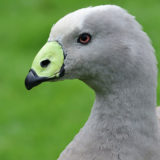CLASSIFICATION
Order: Pelecaniformes
Family: Pelecanidae
Genus: Pelecanus
Species: crispus
RANGE
Dalmatian pelicans appear in a wide range during their migration and breeding seasons. Ranging from central Eurasia, to Taiwan in the west, to the Persian gulf in the south and Siberia in the north. During the winter season, the typically remain in India or the southernmost parts of Europe.
HABITAT
Lake, rivers, deltas, estuaries and other wetland areas.
SIZE
Dalmatian Pelicans are the largest species of pelican and often to thought to be one of the largest flying bird species. The males are roughly the same size as a different species, the great white pelican, though sexual dimorphism makes female dalmatian pelicans larger than their great white pelican counterparts.
Length: 5-6 feet
Weight: 16-34 pounds
Wingspan: 8-12 feet
LIFE EXPECTANCY
35-54 years
REPRODUCTION
- May nest alone, in small groups or in colonies of up to 250 pairs of pelicans. They have also been known to nest alongside great white pelicans.
- They will build nests in lagoons, river deltas or in areas with large amounts of aquatic vegetation.
- Nests are usually built on the ground (although sometimes may be slightly elevated) and are made from reeds, sticks, leaves and droppings to keep the nests together.
- Breeding begins in March and April and females will lay 1-6 eggs that weigh roughly 4-7 ounces.
- Egg incubation is split between both parents and lasts from 30-35 days.
- Young fledge at around 85 days and become independent at 100 to 105 days old.
- Eggs are often susceptible to wild predators including eagles, boars, wolves, foxes and lynx.
DIET
Wild: Diet consists almost entirely of fish including pike, mullet, perch and carp. May also eat crabs, small birds, worms and insects.
BEHAVIOR
This species is known to migrate short distances frequently based on food availability and often prefers warmer temperatures. Once a colony is formed, the pelicans may forage for food together and use their large beak pouches to scoop up larger fish and water; the water being dumped out the sides of the beak pouch while the fish is swallowed.
POINTS OF INTEREST
- Although most species of pelicans are considered social birds, the Dalmatian pelican is considered to be the least social of the group, sometimes opting to nest and forage alone.
- Dalmatian pelicans require almost 3 lbs. of fish per day!
- Migration patterns have been monitored in recent history showing that pelicans have adapted to climate change by migrating more frequently to areas with warmer temperatures.
STATUS
Near Threatened. Not much is known about the decline of the species and it is thought to be brought on by wetlands destruction, nest predation, hunting by fishermen and humans encroaching on the natural habitats. There are thought to be anywhere from 10,000-20,000 left in the wild. The Dalmatian pelican is one of the species to which the Agreement on the Conservation of African-Eurasian Migratory Waterbirds (AEWA) applies and efforts have been taken (specifically in Europe) to help encourage the breeding and safety of this species.






